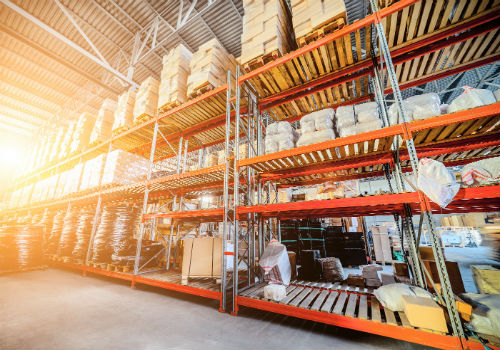Efficient warehouse storage requires optimal use of space. Warehouse managers should utilize heavy duty shelving units that organize products in a convenient, efficient, and accessible way to ensure this optimal use.
There are a variety of shelving systems available. Whether you need to store long, large items with a low turnover rate or perishable items with a high turnover rate, a variation of industrial shelving will improve your storage space and warehouse organization.

What Kinds of Heavy Duty Shelving are there?
- Steel Frame Shelving
Frame shelving units are versatile and durable. They are spacious and equipped with adjustable shelves that can safely store heavy loads and protect them from damage.
- Wire Shelving
Another easily adjustable storage option is wire shelving. Wire shelves consist of wire mesh welded to load-bearing metal supports. These systems are popular for storage in kitchens and restaurants.
Long Span Shelving
Long span shelving units are longer than most industrial shelving. These are ideal for storage of longer items such as wooden or steel planks. Supermarkets and grocery stores prefer this shelving because it allows for products to be on one long shelf.
- Pallet Racking
Pallet racking systems are perfect for storage of varied goods and products that require fast and easy access. These systems utilize vertical space and can support heavy loads. Pallet racks are perfect for warehouse storage because they prioritize storage and height capacity.
Investing in heavy duty shelving is a perfect way to keep your warehouse organized and your inventory accessible. These systems, while all slightly different, offer major benefits that improve and maintain the overall operation of a warehouse.

Benefits of Heavy Duty Shelving
- Shelving Systems Optimize Space
Heavy duty shelving optimizes warehouse space by utilizing all available space in your facility. With the ability to use all of the space, floorspace is freed up, making access easier and distribution a smoother process.
Products can be stored in an organized fashion based on durability and frequency of use. Goods with infrequent turnover can be stored higher up, and goods that move quickly can be stored at an easily accessible height.
To optimize space in your warehouse, you may also want to consider having a mezzanine level added. A mezzanine is a free-standing structure that acts as a barrier between a section of floor space and your shelving system. Your warehouse racking system sits on top of the mezzanine, while the separate lower level is designated for floor storage.
- Shelving Cuts Cost
Physical warehouse expansion is significantly more expensive than installing a heavy duty shelving system in your warehouse. Expansion requires knocking down walls and rebuilding new ones or relocating your facility.
If you are looking to create additional space in your warehouse rather than remodeling, reconsider your organizational strategy to include a new shelving system. Shelving systems are designed to make storing large quantities of materials simple and convenient, without the cost associated with expansion.
- Shelving Improves Efficiency of Operations
Shelving systems that effectively utilize vertical space will increase productivity in your warehouse. Products are easily accessible from pallet racks and wire shelving than from the warehouse floor.
Also, shelving improves the flow of goods. Because parts and materials can be easily located on shelves, employees no longer must search for materials among disorganized bins and boxes.
Shelving Protects Goods from Damage
Shelving systems protect your products from damage. With the proper shelving system for your materials, the chances of items falling or shifting are much smaller. Warehouse employees are also at less risk for injury due to falling items and difficulty retrieving goods.


